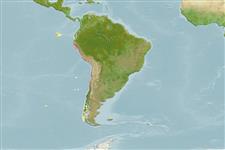>
Blenniiformes (Blennies) >
Blenniidae (Combtooth blennies) > Salariinae
Etymology: Scartichthys: Greek, skaritis, -idos = a jewel stone with the colour of the fish scarus (Ref. 45335); viridis: Latin, viridis = green; refers to the green body coloration in life (Ref. 10696).
More on author: Valenciennes.
Environment: milieu / climate zone / depth range / distribution range
Écologie
marin démersal; profondeur 0 - 10 m (Ref. 10696). Subtropical
Southeast Pacific: Independencia Bay, Peru to Valparaiso, Chile.
Taille / Poids / Âge
Maturity: Lm ? range ? - ? cm
Max length : 19.7 cm SL mâle / non sexé; (Ref. 10696)
Épines dorsales (Total): 12; Rayons mous dorsaux (Total): 17-19; Épines anales 2; Rayons mous anaux: 19 - 20. Distinctive in having a relatively uniformly pigmented body without spots; further differentiated from S. gigas and S. variolatus in having a high number of dentary teeth, 106-131 (versus 93 or fewer).
Adults are found in tide pools and rocky shore areas. Are primarily herbivorous (Ref. 9032). Selectively feed on the green algae Ulva, Enteromorpha, as juveniles and favor red algae Gelidium as adults (Ref. 94105). Oviparous. Eggs are demersal and adhesive (Ref. 205), and are attached to the substrate via a filamentous, adhesive pad or pedestal (Ref. 94114). Larvae are planktonic, often found in shallow, coastal waters (Ref. 94114).
Life cycle and mating behavior
Maturité | Reproduction | Frai | Œufs | Fécondité | Larves
Oviparous, distinct pairing (Ref. 205).
Williams, J.T., 1990. Phylogenetic relationships and revision of the blenniid fish genus Scartichthys. Smith. Contrib. Zool. 492:1-30. (Ref. 10696)
Statut dans la liste rouge de l'IUCN (Ref. 130435)
Menace pour l'homme
Harmless
Utilisations par l'homme
Plus d'informations
RéférencesAquacultureProfil d'aquacultureSouchesGénétiqueElectrophoresesHéritabilitéPathologiesTraitementNutrientsMass conversion
CollaborateursImagesStamps, Coins Misc.SonsCiguateraVitesseType de nageSurface branchialeOtolithesCerveauxVision
Outils
Articles particuliers
Télécharger en XML
Sources Internet
Estimates based on models
Preferred temperature (Ref.
123201): 14.8 - 20.6, mean 19.5 °C (based on 102 cells).
Phylogenetic diversity index (Ref.
82804): PD
50 = 0.5625 [Uniqueness, from 0.5 = low to 2.0 = high].
Bayesian length-weight: a=0.00661 (0.00340 - 0.01283), b=2.96 (2.79 - 3.13), in cm total length, based on LWR estimates for this species & (Sub)family-body (Ref.
93245).
Niveau trophique (Ref.
69278): 2.2 ±0.1 se; based on diet studies.
Résilience (Ref.
120179): Milieu, temps minimum de doublement de population : 1,4 à 4,4 années (Assuming tm=1 and Fec=100-1000).
Fishing Vulnerability (Ref.
59153): Low vulnerability (14 of 100).
Nutrients (Ref.
124155): Calcium = 172 [83, 366] mg/100g; Iron = 1.23 [0.71, 2.35] mg/100g; Protein = 18 [17, 19] %; Omega3 = 0.175 [0.091, 0.332] g/100g; Selenium = 16.5 [7.7, 38.1] μg/100g; VitaminA = 16.7 [4.3, 63.8] μg/100g; Zinc = 1.4 [0.9, 2.1] mg/100g (wet weight);
